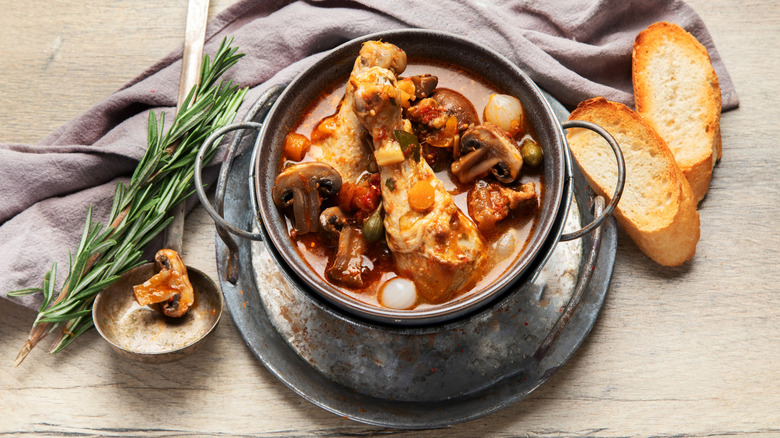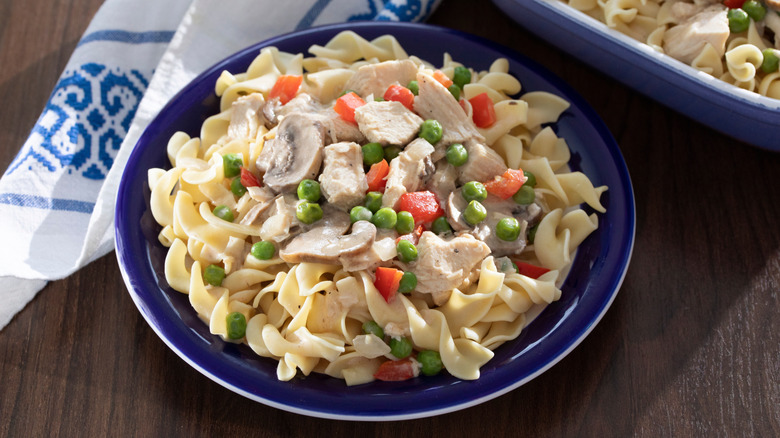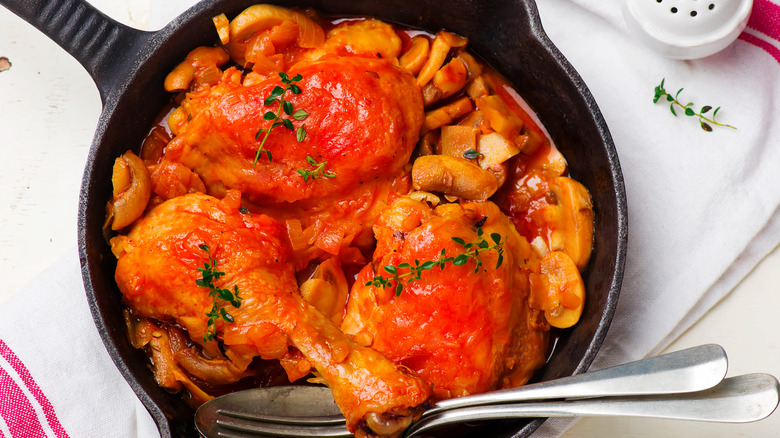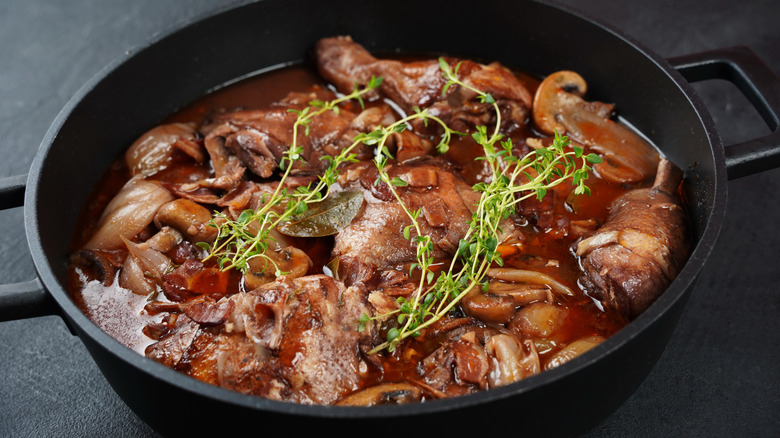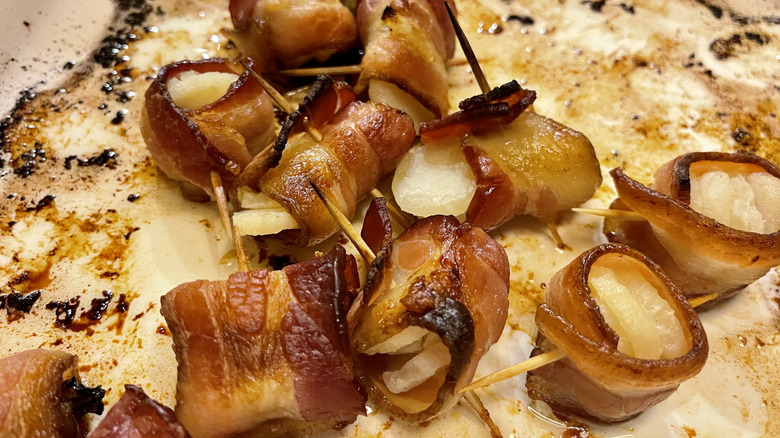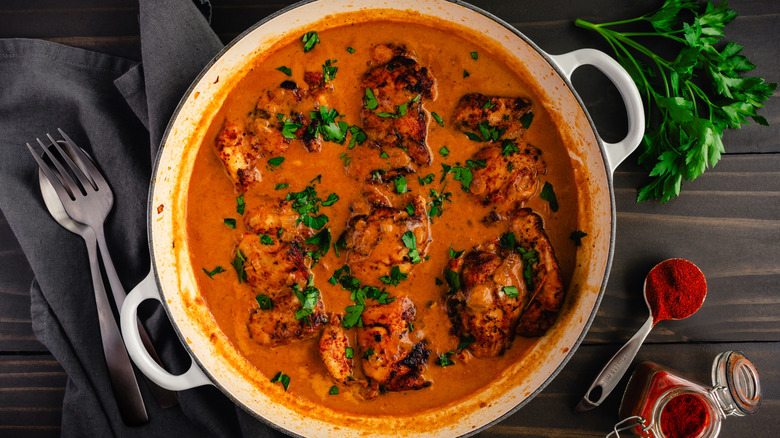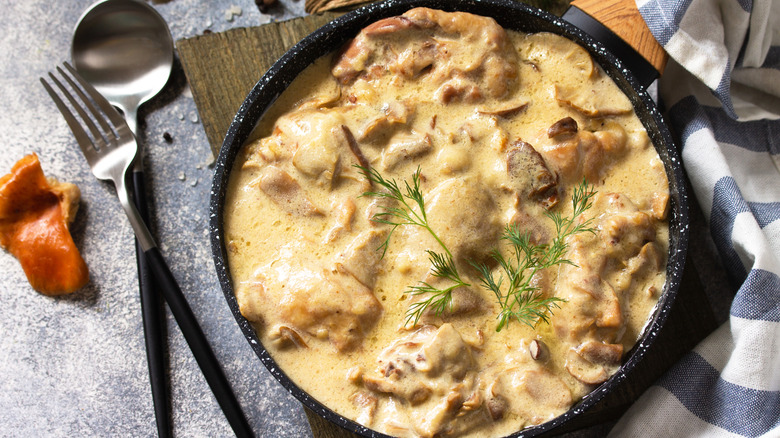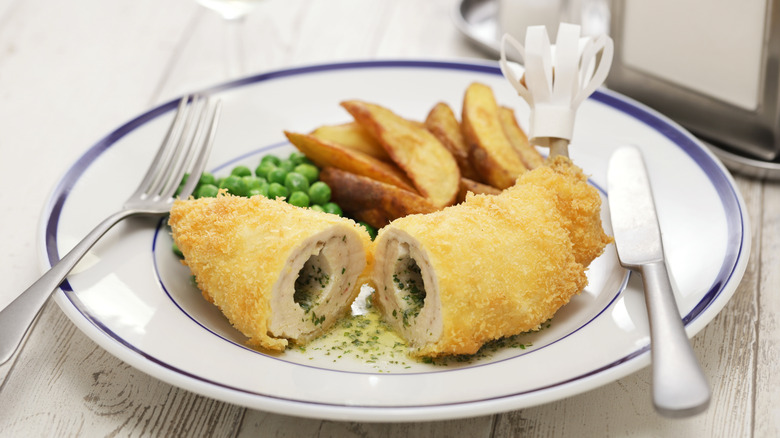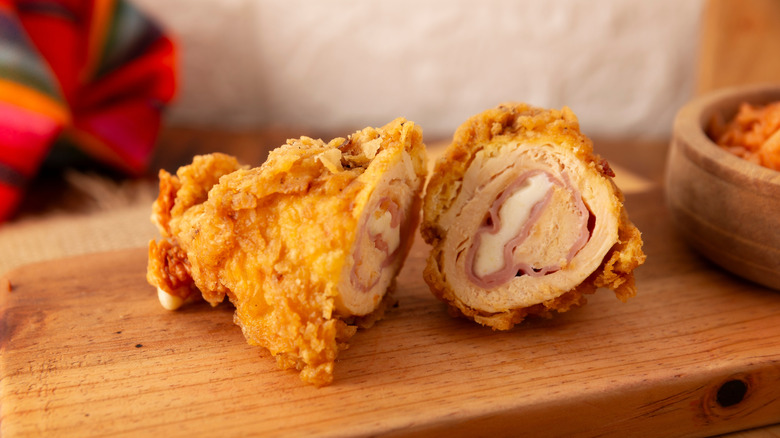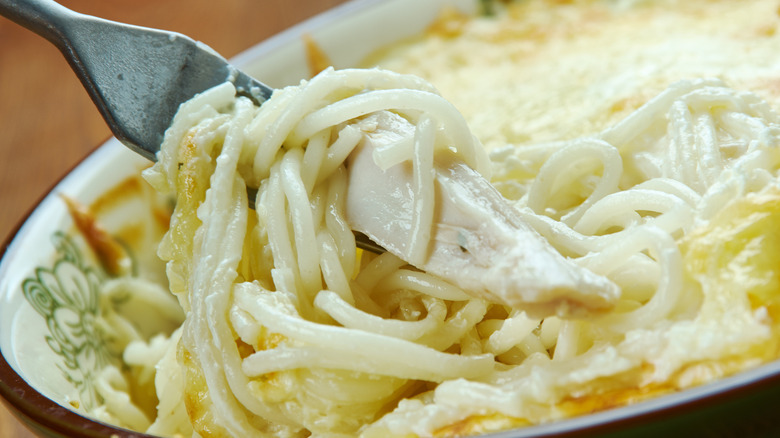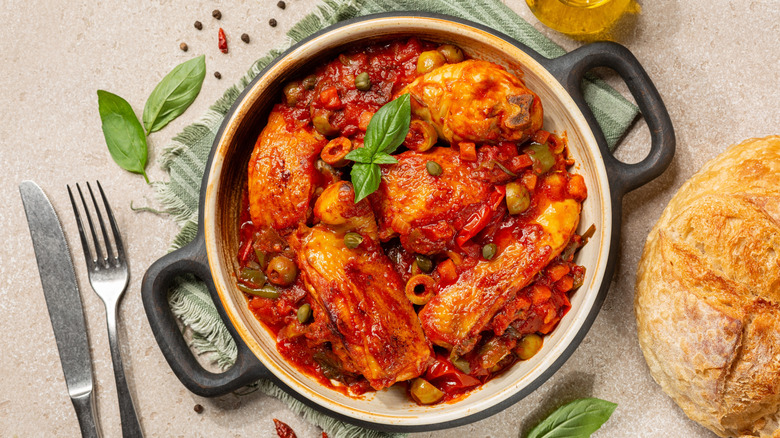Vintage Chicken Dishes That Restaurants Hardly Make Anymore
What's your favorite chicken dish? It's kind of a hard question to answer, right? That's probably because there are so many of them out there. Chicken is the most popular meat both worldwide and in the United States, and while opinions vary on why that's the case, we'd put its appeal down to its combination of versatility and affordability. Over the years, chicken has been used in countless different dishes as a relatively cheap source of protein that can adapt itself to tastes in various recipes — but as times have changed, so have the ways that we use it, and there are plenty of chicken dishes out there we don't see as much any more.
Many vintage chicken dishes have since taken a backseat on restaurant menus, and are rarely seen in eateries. Try and find chicken paprikash, coq au vin, or rumaki in most modern restaurants and you'll likely be disappointed. While these might be meals you make in the comfort of your home, restauranteurs have figured out that many of these chicken dishes represent a bygone food era, and you'll just have to make do with reading about them here.
Chicken à la King
There was a time when chicken à la king was the go-to meal for folks wanting something fancy. This dish was allegedly invented at the start of the 20th century, and despite its name it has nothing to do with royalty, or indeed with France. Instead, the story goes that it was put together to honor E. Clark King II, the owner of the Brighton Beach Hotel in New York. The chicken dish immediately took off, and for several subsequent decades it was seen on menus all around New York State, where it was seen as the pinnacle of fine dining.
For all of the fuss around it, though, chicken à la king is relatively simple. The dish consists of chicken breasts, stock, cream, and butter, combined with various vegetables in a stew. Chicken à la king was commonly served over toast, topped with some flaky biscuits, or thrown into a pie. It was this combination of luxury and comfort that drew people to it, but its days were unfortunately numbered. Chicken à la king fell out of vogue, and by the mid-1980s it was a rare sight in restaurants. Nowadays, you'll only find it in the most old-fashioned of places.
Chicken à la Marengo
Despite having an Italian place in its name, chicken à la marengo is a French creation. The dish was allegedly invented after the infamous Battle of Marengo in 1800, when Napoleon Bonaparte's chef managed to find some ingredients in the ransacked town and threw together the recipe in an off-the-cuff manner. Apparently, Napoleon was so enamored with the result — chicken thighs coated in a tomato and mushroom sauce, often completed with fried eggs and crawfish — that it became a favorite, and a classic was born. While opinions vary on the actual origins of chicken à la marengo, the dish subsequently became a popular one in recipe books in the 19th century, with folks clamoring to try this fabled meal.
However, if you're looking for it in restaurants today, you'll likely be disappointed. Chicken marengo is one of those bygone chicken meals that now feels decidedly retro, and you likely won't find it in most mainstream French restaurants that cater to modern tastes. You might be more lucky in more intimate, family-run bistros, particularly as this is a dish that's somewhat designed to be easy to make in slightly more simple settings. However, it's far from mainstream by 2025 standards.
Coq au vin
It might surprise you to see coq au vin on this list. After all, this chicken dish is one of the most famous French poultry-based meals out there, thanks in part to chefs like Julia Child boosting its popularity. However, you'd be hard-pressed to find it on restaurant menus these days. While coq au vin is still an at-home favorite, it's taken on a decidedly retro air in recent years, and most folks associate it with mid-century food habits. Restaurants certainly do, at least: You're unlikely to find it in many mainstream eateries these days.
It's a shame, too, as coq au vin is undeniably delicious and has a long lineage. This dish only started being formalized in cookbooks around the 19th century, but it's thought to have been made for hundreds or even thousands of years before this, and is just one of a long line of braised stews that were popular amongst peasants and individuals living in the countryside. Its combo of chicken, wine, and root vegetables gives it a rustic feel and a surprising amount of complexity. It's just a shame that rustic sense doesn't translate well to today's food culture.
Chicken Marbella
Chicken marbella is one of those dishes that feels like it's older than it actually is. This lip-puckering chicken dish first appeared in cookbooks in the 1980s, having been devised several years before by Sheila Lukins, the owner of a catering company that operated in Manhattan. Lukins, along with her friend and business partner Julee Rosso, immortalized the dish in print, and chicken marbella quickly became a staple of restaurant menus and holiday parties alike.
This Mediterranean-inspired dish is positively bursting with flavor, thanks to the inclusion of olives, capers, oregano, red wine vinegar, white wine, and garlic. The tart, yet sweet profile gives it a dynamism that pairs well with the chicken's lighter taste, and the inclusion of prunes in the dish give it a maltiness that adds depth. Sadly, though, just as quickly as this dish's popularity rose, it faded. Chicken marbella was the talk of the town for a hot sec, and then it was relegated to the history books as an '80s curio.
Rumaki
If you ever dined at a Trader Vic's back in the 1950s or '60s, you may well remember rumaki — and if you didn't, we wouldn't be surprised if you've never heard of it. This chicken-based appetizer was a true mid-century affair, and a Polynesian-inspired dish that has since faded from memory for a lot of folks. Rumaki wasn't invented by Trader Vic's and instead seemed to first appear on the menu of Don the Beachcomber, a Palm Springs-based restaurant founded by Donn Beach, considered by many to be the biggest pioneer of "tiki culture" in the United States. However, it was at Trader Vic's that it found its biggest audience.
Rumaki is unique in that it skips more mainstream cuts of chicken, and instead opts to use chicken liver. Each piece of liver is topped with a water chestnut and then wrapped in bacon. The whole construction is bathed in soy before being cooked until the outside is crispy and the inside remains juicy and savory. Perhaps the decline of eating organ meat led to rumaki's demise and eventual removal from the Trader Vic's menu, and its subsequent disappearance from food culture. If you want to try it, it's easy enough to make at home.
Chicken paprikash
It feels unfair to call chicken paprikash a '60s dish, given that it still holds huge popularity in certain parts of the world — but when it comes to the U.S., that's kinda what it is. This dish, which consists of chicken cooked in a broth of paprika and onions, originated in Hungary, and is thought to have travelled to the United States with the large influx of Hungarian immigrants who moved from the European country during the 19th and early 20th centuries. These communities settled in cities like Cleveland, with the families and individuals who moved there setting up shop and opening restaurants which served the dish.
Chicken paprikash, which is thought to have been invented in around 1920, took off big time, with the dish being served in restaurants and cooked in home kitchens alike. Sadly, the years have seen many of these restaurants close, and chicken paprikash's heyday as a mainstream dish has since passed. That doesn't mean you can't still find it in Hungarian eateries, though, especially those in Hungary itself. Plus, if you're making it at home, it generally takes just a few key ingredients — although Hungarian paprika is non-negotiable, so don't think you can sub it out, people.
Chicken almondine
Chicken almondine is one of those dishes that just feels old-school. This chicken dish seems like it was flown straight out of the 1970s, those decades where food culture tended to try and make things fancy while somehow keeping them fairly unsophisticated. A bygone dish, chicken almondine combines (as you might expect from its name) poultry and almonds. Chicken tenderloins are coated with flour and Herbes de Provence, before being cooked in butter, white wine, and chicken broth. They're then topped with buttery, toasted almonds, which give the tenderloins a nutty crunch. Kinda weird, but hey, we'll take it.
Crucially, chicken almondine shouldn't be confused with almond chicken, an American-Chinese dish which is still enjoyed across the country. This dish falls into a long line of American-Chinese cuisine combining meat with nuts, and has the same savory-sweet flavor profile. One version, almond boneless chicken (or ABC) is virtually a staple of Detroit, and is distinguished by its crispy, deep-fried nature and rich gravy topping. Both almond chicken and almond boneless chicken have stood the test of time, but chicken almondine has not.
Chicken divan
There's kind of a trend in 20th century food culture of giving dishes French names in a bid to make them seem fancier, despite them being invented in the United States. This happened with chicken à la king, and it happened with chicken divan. The latter was a chicken dish that was invented at the Divan Parisien restaurant at the Chatham Hotel in New York City — but I guess we can let this one slide, given that it's named after the joint it came into being at. Chicken divan first appeared on the menu in the early decades of the 20th century, and was invented by chef Anthony Lagasi, who famously refused to tell anyone the exact recipe.
Well luckily, it's not too hard to figure out what went into it. Chicken divan is a combination of chicken breasts which are piled on top of pieces of broccoli and topped with a white sauce. The dish is scattered with parmesan cheese, and the casserole is then broiled in the oven until everything is cooked and bursting with flavor. Interestingly, chicken divan is one of the first examples of broccoli and chicken in mainstream American cuisine, a combo that would become incredibly popular as the years went on. Chicken divan had its heyday during the middle of the 20th century, but after a while it began to feel a little too old-school. Soon, restaurants everywhere were dropping it from their menus.
Coronation chicken
The United Kingdom gets a bad rep for its food culture, with a lot of its national dishes being dubbed as a little unrefined (although we defy anyone to tell us that a Sunday roast isn't delicious). It's arguable that coronation chicken works against that perception. This chicken dish, which is undeniably very retro, was invented in 1953 by chefs at Le Cordon Bleu school in Marylebone, London. The dish was conceived to celebrate the coronation of Queen Elizabeth II, and was (and is) a combination of chicken coated in a creamy curry sauce, served with rice and green peas.
The dish was a success, enough for it to become a favorite on restaurant menus as folks wanted to try what the Queen herself had been eating. This initial flurry of activity soon died, and the dish eventually became associated with the mid-20th century — although if you're ever in a British supermarket, you can readily find it piled into affordable pre-packaged sandwiches. If you want to try this dish in the United States, you'll probably have to seek out a British-themed establishment. Californians can try Ye Olde King's Head, a self-styled British pub located right on the beach in Santa Monica, which serves a coronation chicken sandwich.
Chicken fricassee
Chicken fricassee is one of those dishes that's been around for hundreds of years, but only started appearing on restaurant menus relatively recently — before disappearing once more. A fricassee is a French style of cooking that involves simmering meat in a thick, white sauce spiked with aromatics, stock, and vegetables. Chicken fricassee has likely been around since the Middle Ages, and like many other braised or stewed dishes was favored by people for its heartiness and ability to use up a host of readily-available ingredients.
Chicken fricassee was apparently a favorite of President Lincoln, but it was in the 1920s that it really started to take off in the United States. Home cooks liked the fact that the dish could make good use of an entire chicken and make it go a long way. Although it was primarily the kind of meal that folks would prepare at home, it wasn't too hard to find it in restaurants, particularly if there was a French chef present. Eventually, though, chicken fricassee morphed into one of those dishes that was associated with a lack of refinement, particularly when food technology made it easy to make with processed ingredients. Nowadays, you won't find it anywhere.
Chicken Kyiv
The chicken Kyiv (formerly known as the chicken Kiev prior to 2022, before the world began embracing the Ukrainian spelling following the Russian invasion of Ukraine) is a thing of beauty. Anyone who's tried this chicken dish will tell you how tasty it is, and how effective the combination of chicken meat and smooth, sharp, garlicky butter is on the palette. Although the chicken Kyiv is named after the capital of Ukraine, it actually has its beginnings in French food culture. The chicken Kyiv was first brought to Ukraine by chefs who had gone to Paris to learn their trade. They learned a version of the dish made with veal, and when they got back to their home country the chefs started making it with chicken. A classic was born.
The chicken Kyiv was a hit in Ukraine and Russia, but it only started to gain traction in the United States after World War Two. The dish — which is essentially pounded chicken that is coated in butter and breadcrumbs, and then fried or baked to perfection — began to be served in restaurants around New York, in part to appeal to Russian and Ukrainian immigrants in the city and beyond. The middle of the 20th century was big for this dish, but by the late 1970s it started to take on an outdated air. Now, you'll mainly find chicken Kyiv in the freezer section of your local supermarket, instead of on a menu.
Chicken cordon bleu
If someone says the words "cordon bleu" to you, you probably think of an incredibly skilled chef, right? That association comes of course from Le Cordon Bleu, arguably the most famous cooking school in the world and a producer of some of the finest cooks in the land. However, the name "cordon bleu" can also be applied to dishes that really excel themselves — and one of these, chicken cordon bleu, is a fancy poultry dish that now feels a relic from a former era.
Chicken cordon bleu isn't super easy to make, but it's definitely worth it. The dish consists of a pounded chicken breast stuffed with ham and cheese, with the construction covered in breadcrumbs and then baked or fried until golden brown. It's then normally sliced into small rounds, with each piece showing off its dynamic, stuffed structure. Chicken cordon bleu hit the big time in the 1960s in the United States, with the story going that soldiers who were stationed in Europe during the war created demand for it back home, as they hankered for the tastes they developed abroad. Eventually, though, chicken cordon bleu was phased out of popularity as tastes developed.
Chicken tetrazzini
Chicken tetrazzini is one of those dishes that most people have tried, but it's likely that you haven't had it in a restaurant recently. This famous spaghetti dish may feel Italian, but it's been developed with an American audience in mind, and in the 1960s and 1970s it became a go-to meal for folks who needed to use up leftover cans of creamed soup. Before all that, though, it was once a restaurant dish. Chicken tetrazzini, which was invented to honor the elegant Italian coloratura soprano Luisa Tetrazzini, was apparently first served in a New York restaurant in 1908. Sources point towards said restaurant being Lorber's, although opinions vary about where it actually was.
The point, though, is that it used to be the kind of dish that felt like a special treat to order, thanks to its creamy combo of chicken, cheese, sauce, and spaghetti. However, over time, the shine dulled on this meal. Chicken tetrazzini quickly became a one-stop shop for whatever home cooks had sitting in their fridge, and its early fanciness disappeared.
Chicken cacciatore
We personally think it's a shame that chicken cacciatore isn't more popular than it is on restaurant menus these days. This classic Italian dish, which literally translates to "hunter's chicken," has been around for hundreds of years. Like many older dishes from European countries, it's a stewed affair, with the poultry simmered with tomatoes, onions, red wine, and various aromatics.
There was once a time when you could find chicken cacciatore on Italian restaurant menus all over the United States, and you may well still be able to hunt it down (if you'll excuse the pun) in more traditional eateries. However, if you're eating mainstream, you'd be hard-pressed to find this rustic dish anywhere. Its hearty nature may have made it a staple once, but head into restaurants like Olive Garden or Bucca di Beppo and it's nowhere to be seen. Instead, many popular Italian restaurants these days focus on Italian-American hybrid dishes, rather than the classics.
